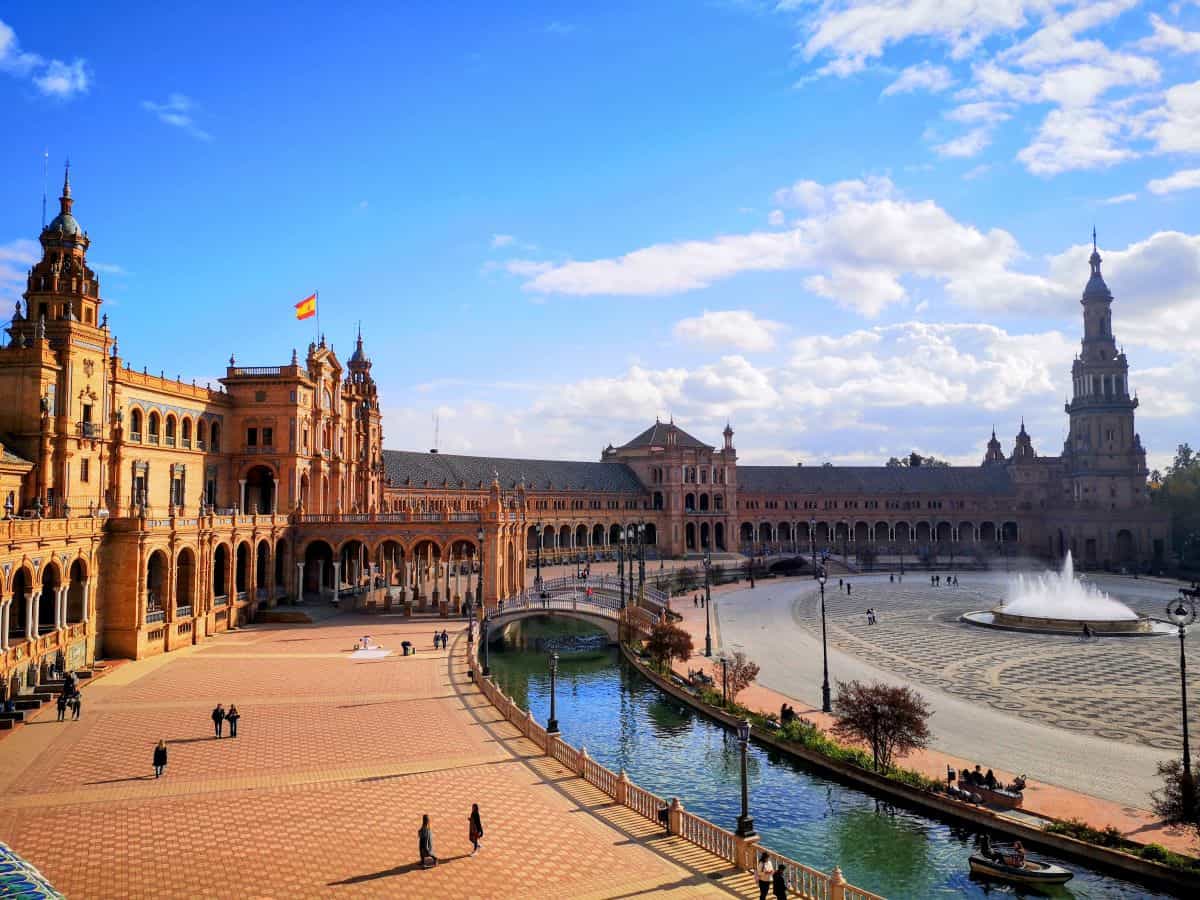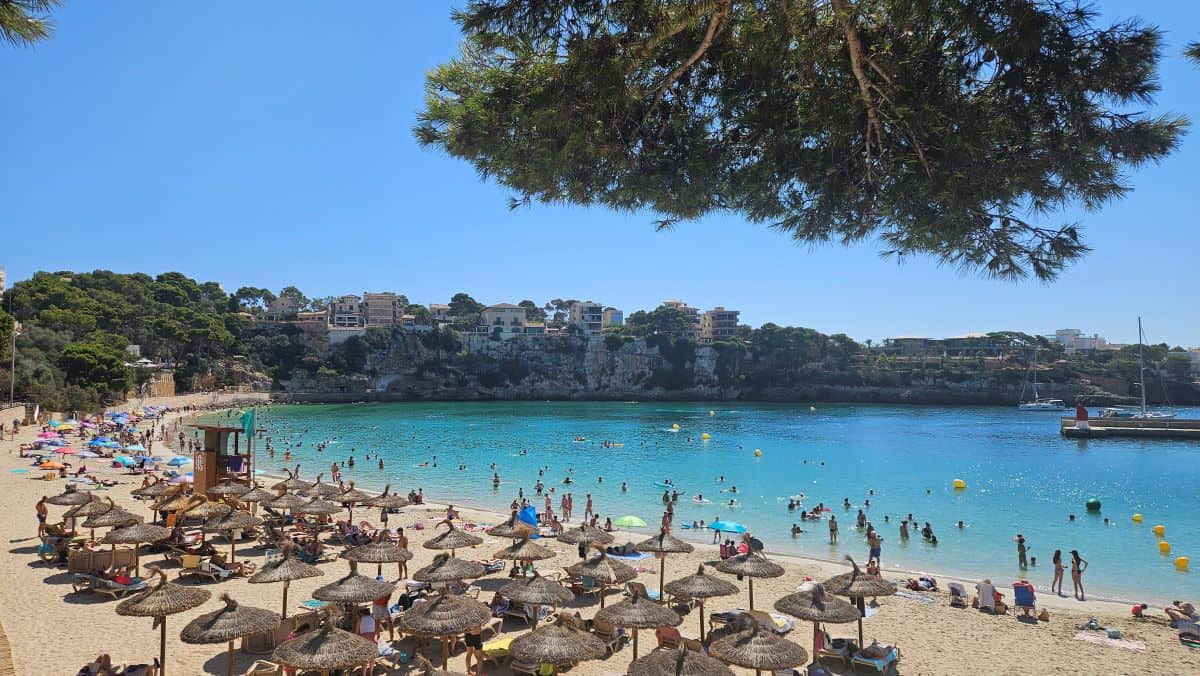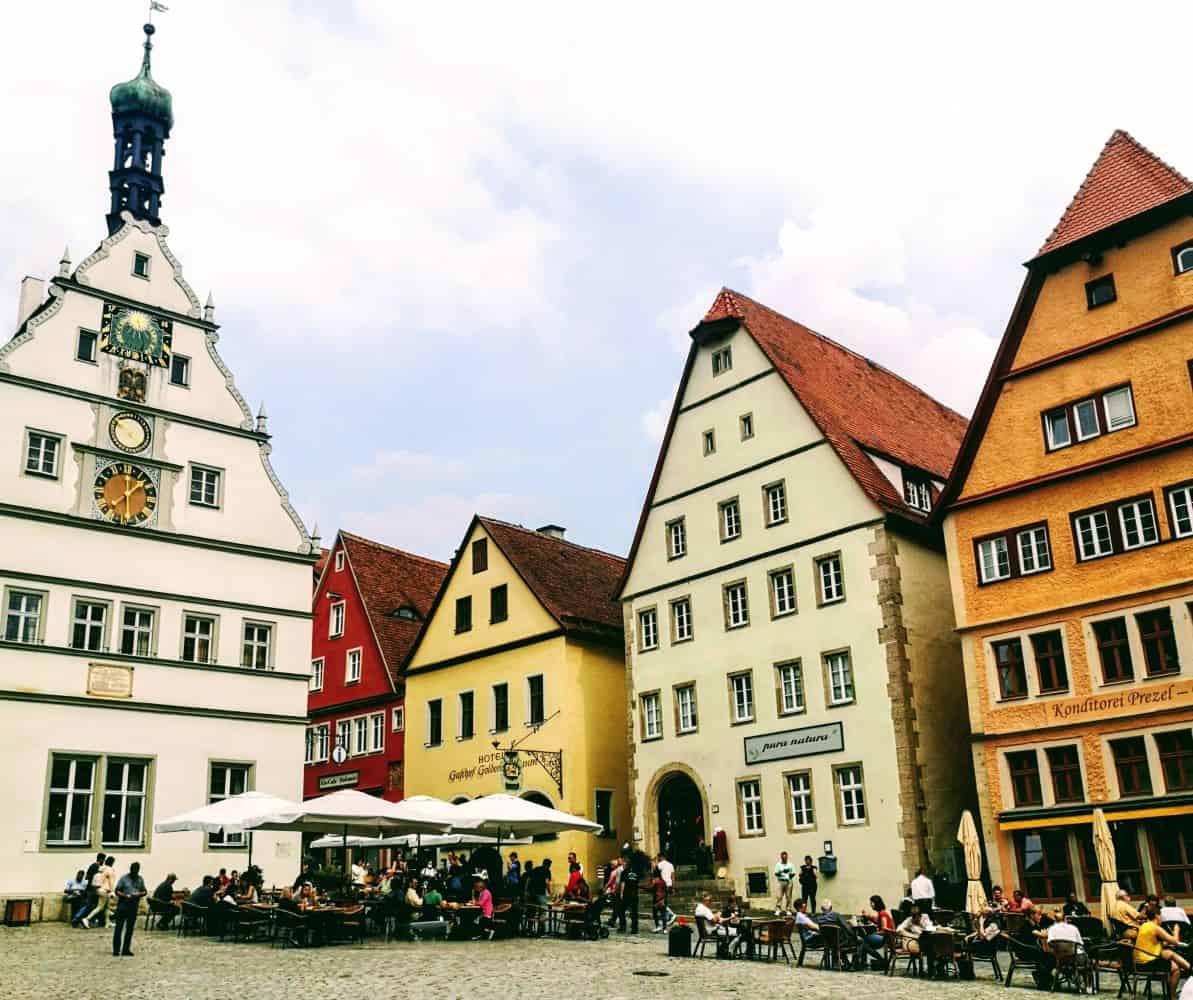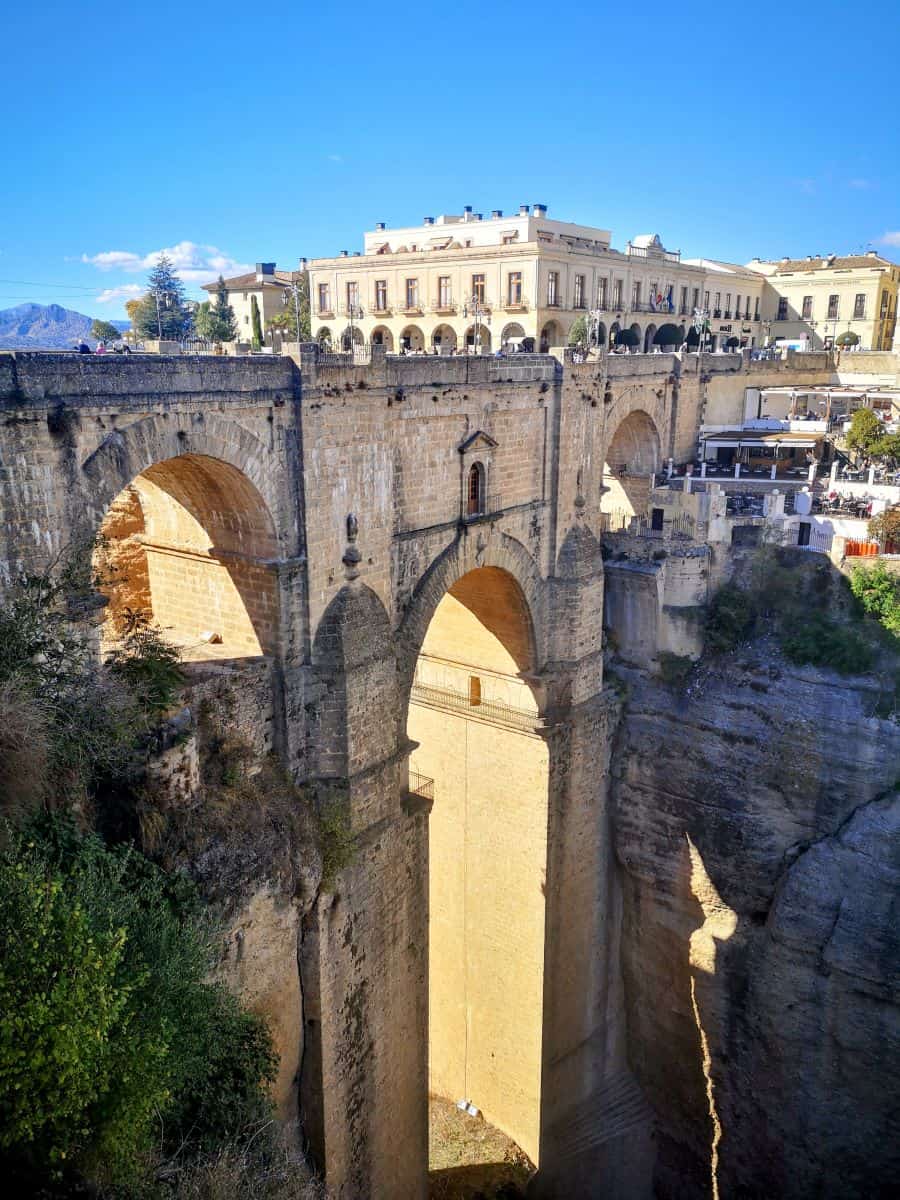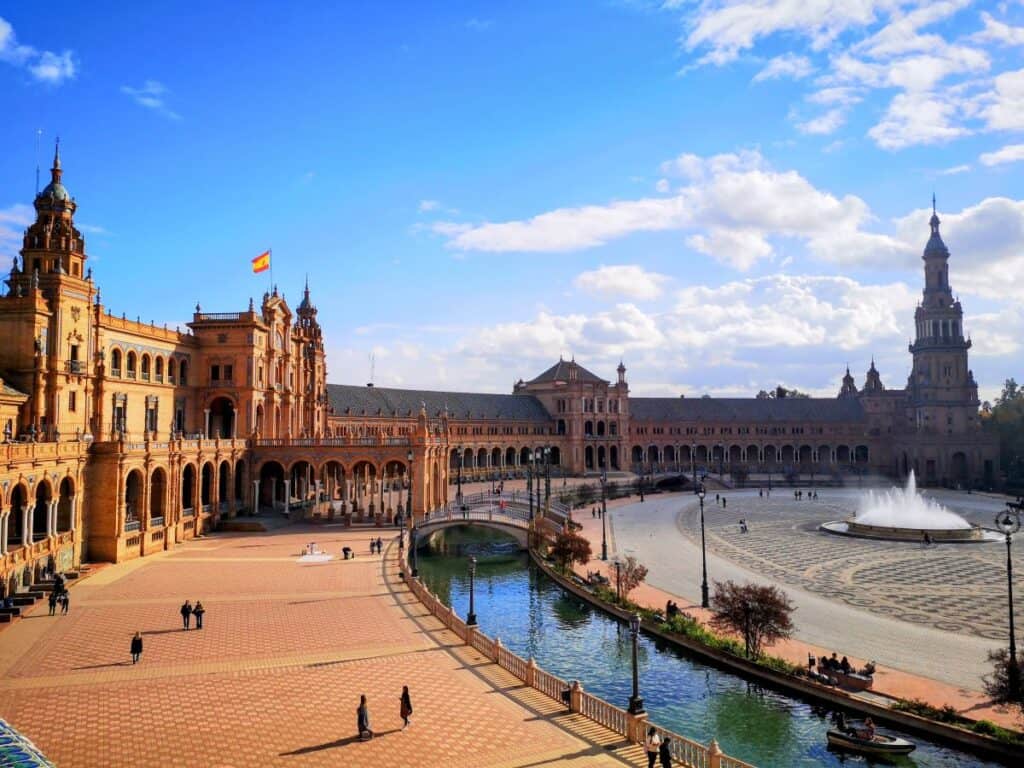
This post may contain affiliate links. I will receive a small commission if you use these links.
Table of Contents
Ultimate Seville travel guide
Plan your perfect trip to Seville with this handy guide!
Seville is one of the most popular city break destinations in Southern Spain. It is a great place to visit for a long weekend, or as part of a Spanish road trip. In this guide, I’ll cover all the key things you need to know about planning your perfect trip to Seville, including when is the best time to visit Seville, how to get there and some of the best things to see and do in Seville.
How many days do you need in Seville?
Many people choose to visit Seville on a long weekend, or a city break. However, Seville is also a great destination to include in your itinerary for a longer trip touring around the beautiful region of Andalusia, in Southern Spain.
I would recommend spending 3-4 days in Seville. This will give you a good amount of time to visit all the main sights and attractions of Seville without having to rush around to fit it all in. If you want to extend your stay, there’s also some great day trips from Seville.
How to get to Seville
By Plane: Seville airport is very small, and although it does have a handful of flights everyday, it is most likely that you will fly into either Madrid or Malaga.
By Train: The most convenient way to travel to Seville is by train. Seville’s Santa Justa Train Station is located on the edge of the Centro neighbourhood and main tourist area of the city. From Malaga, you can take a 2 hour train direct to Seville. A one way journey will cost approximately €46. From Madrid, the train to Seville takes 2 hours 45 minutes and will cost approx. €26.
From Seville train station, it is a 30 minute walk (approximately 2km) into the centre of Seville. Alternatively, you can catch a taxi which will take 20 minutes.
Getting around Seville
Seville is a very walkable city. In fact, much of the El Centro area is pedestrianised, or has one way roads. So the best way to get around Seville is on foot.
If you are staying in the El Centro area, in the heart of the tourist neighbourhood, then you can walk to most of the sights and attractions in around 20 minutes. If you are not able to walk far, then another great option is the Hop on, Hop off sightseeing bus.
If you are staying further away from the attractions, in the outskirts of Seville, there is a public tram and bus network which you can use to travel to the centre.
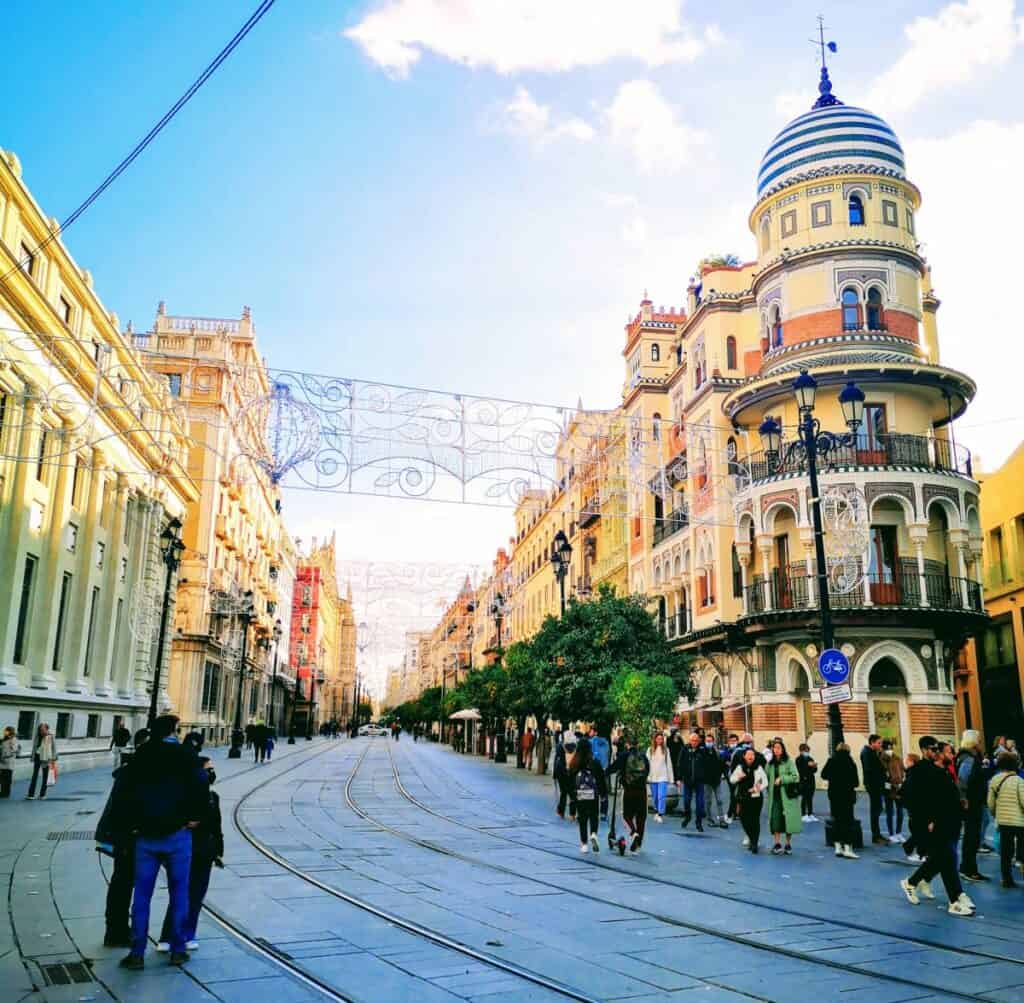
Where is the best place to stay in Seville?
As I mentioned above, most of Seville’s main sights and attractions are located in the El Centro neighbourhood, in the centre of the city. El Centro is definitely the best place to stay in Seville if you want to be in the middle of everything. Although, as you would expect, accommodation in El Centro is more expensive than on the outskirts of the city.
Surrounding El Centro is the Santa Cruz (Jewish) neighbourhood and the La Macarena neighbourhood.
Santa Cruz is known as Seville’s Jewish quarter. This pretty neighbourhood is a maze of narrow, cobbled streets and pretty buildings. It’s great to spend an hour or so exploring this area. There’s also lots of small cafes and tapas bars to be found here.
The area of La Macarena is becoming quite a trendy part of Seville. It is popular with a younger crowd and you’ll find a good mix of bars, clubs and restaurants. Staying in La Macarena is a great choice for finding more budget-friendly accommodation in Seville.
Across the river from El Centro is the neighbourhood of Tirana. In this area, you’ll find more family friendly tavernas and restaurants. You’ll also find cheaper accommodation on this side of the river. Tirana has less of a buzz, so if you are looking for somewhere quieter, this could be a good option for you.
When is the best time of year to visit Seville?
Seville is a large, bustling city. And as you would expect from any big, modern city, the attractions, bars and restaurants stay open all year round. This makes Seville a great city break destination to visit at any time of the year.
Seville in Summer
The average daily high in Seville throughout the peak summer months of July and August is 36 degrees Celsius. However, Summer in Seville can see temperatures reach up to a sweltering 40 degrees Celsius! This has caused Seville to be named as the hottest city in Europe during the summer.
Even if you are someone who enjoys the sun, Seville can be quite unbearable in the summer heat. Not all accommodation has air conditioning, especially in the more budget friendly hostels and guesthouses, and there are not lots of accommodation options with a pool.
Personally, I would avoid visiting Seville in the heat of the summer, and instead, choose to visit in the Spring or Autumn months.
Seville in the Spring and Autumn
The Spring months of March – May or the Autumn months of September – November are both great times to visit Seville. During the Spring and Autumn seasons, the temperature is mild and the days are lovely and sunny.
During September, average temperatures are still quite high at 32°C, so this is a great time to visit if you like it quite hot. Even in May and October, average temperatures are around 26°C.
I visited Seville towards the end of November, which I would really recommend. The weather was still warm and mild during the day. Accommodation prices were lower as it was officially the ‘off-season’. However, there were still lots of tourists around, creating a good atmosphere, without it feeling too busy.
Seville in the Winter
Spain is a great destination to visit in the winter months and I’ve spent time in Malaga and the Costa del Sol during the winter and loved it. Visiting Seville in December, you will be able to experience the Christmas market and enjoy the Christmas decorations which are all around the main El Centro neighbourhood.
January and February are the cheapest months to visit Seville. This is also the least crowded time of year to visit. Even in January and February, you will still get average temperatures of 16°C during the day.
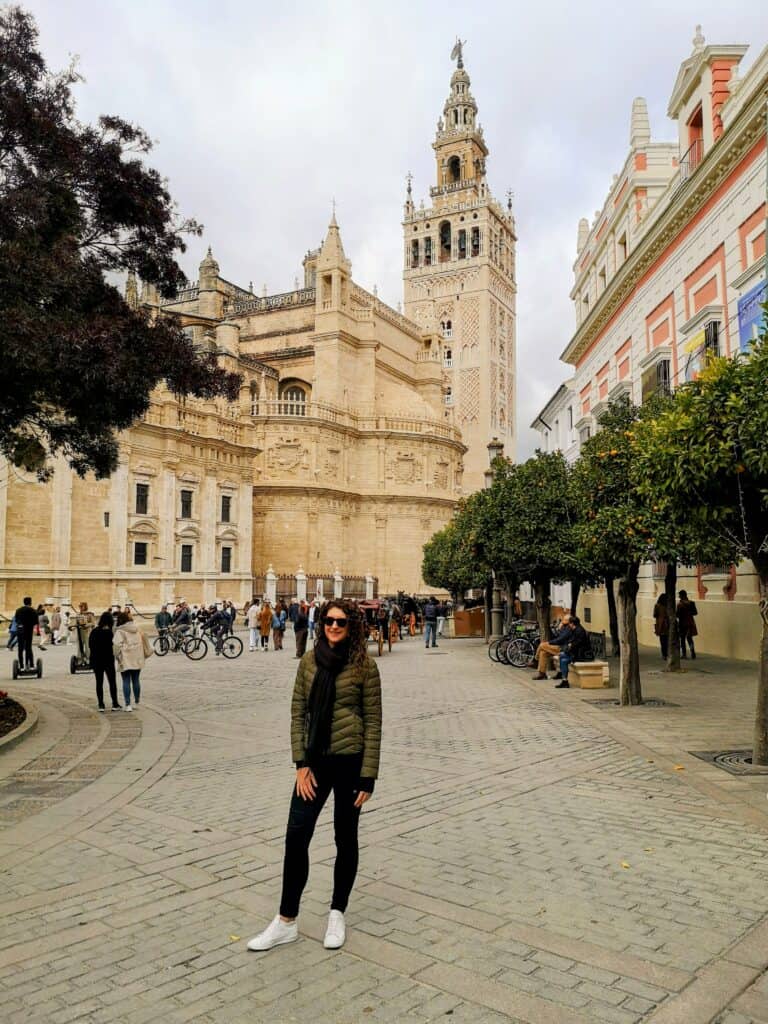
Best things to do in Seville
Here’s some of the best sights and attractions to see whilst you are in Seville:
Cathedral de Sevilla
Opposite the Royal Alcazar is the city’s other most visited attraction – the Cathedral of Seville. This impressive gothic cathedral is an absolute must-visit when in Seville. The intricate detail of the decor and carvings on the inside is incredible. You can also visit the Giralda (bell tower) – which I would highly recommend. The steps up to the top will be worth it as you’ll be rewarded with fantastic skyline views over the city. In fact, this is the best city view in Seville!
As with the Alcazar, I would highly recommend purchasing your ticket in advance to avoid long queues. It is also slightly cheaper to purchase online, at €12 per adult (instead of €13 at the ticket office)
Plaza del Triunfo
This small Plaza sits in between the Royal Alcazar and the Cathedral. It can get quite busy here during the day, but in the morning you can enjoy it whilst it is a bit quieter. This is also a great meeting spot if you are travelling with others and need to arrange a rendezvous point!
Royal Alcázar of Seville
The Royal Alcazar is one of the most visited attractions in the centre of Seville. A wander around the 16th century palace and its landscaped gardens is a lovely way to spend a couple of hours. The gardens are particularly beautiful, especially between the Spring and early Autumn months.
There can be a very long queue to enter the Alcazar, especially during peak season and in the middle of the day. Even in November, I experienced long queues! I would definitely recommend booking in advance if you can. Otherwise, you can purchase tickets at the official ticket office in the Patio de Banderas, which is a small square around the corner from the main entrance to the Alcazar. Once you have purchased your tickets, head back to the main entrance (identified by the red Puerta del León gates) and join the queue to enter. Tickets are €13.50 for general admission.
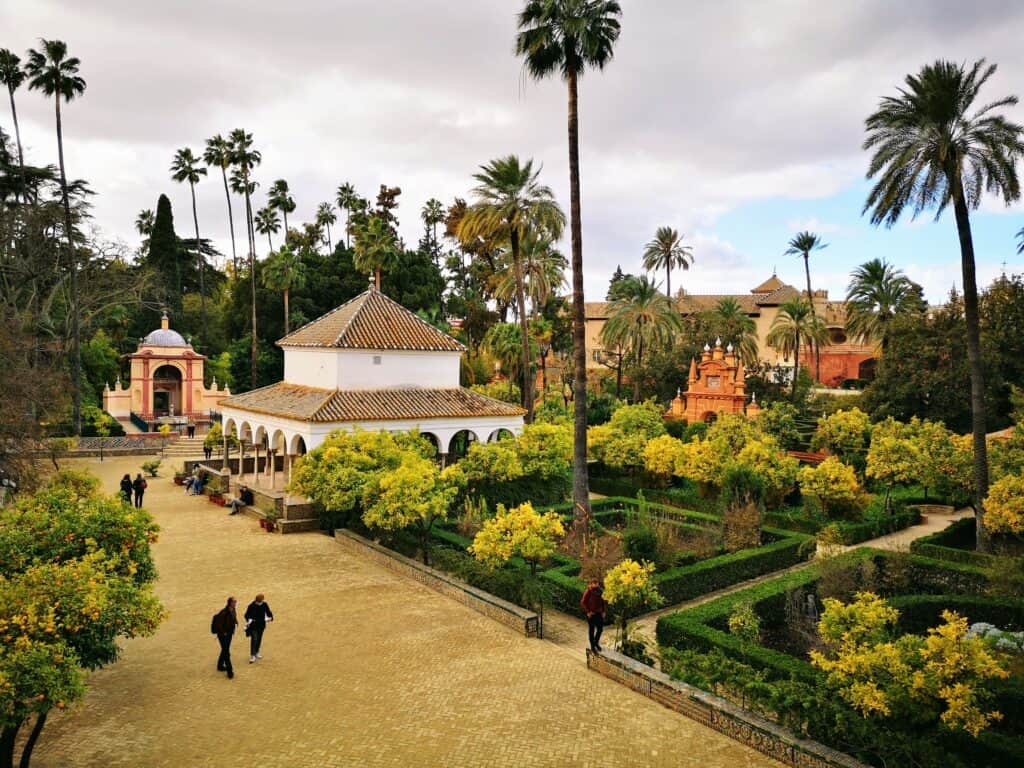
Avenue de la Constitución
This is one of the main streets, running right through the centre of the city, past the Alcazar and Cathedral. The tree-lined street is lined with shops and cafes, with tram stops along the way.
Plaza de España
You can’t go to Seville and not visit the Plaza de Espana! It has become one of the most photographed and recognisable sights in Seville. This famous plaza has an impressive curved building, holding various government offices. Several bridges curve over a shallow water feature and small rowing boats can be hired out to take out onto the water for a photo opportunity. You can wander around the Plaza for free, however there is a small charge to hire the rowing boats.
This is a great place to sit and enjoy watching the world go by. You can also see the various colourful tiled benches which have been created as part of the main building.
Parque de María Luisa
In front of the Plaza España is the sprawling Maria Luisa park. In the hot summer months, this is a great place to cool off under the shade of the trees. There is an abundance of paved walking trails all over the park, as well as benches, and small squares with water fountains. At the far end of the park, you will also find several historic landmarks and the Museum of Popular Arts and Traditions, which houses various exhibitions on arts, local traditions and costumes.
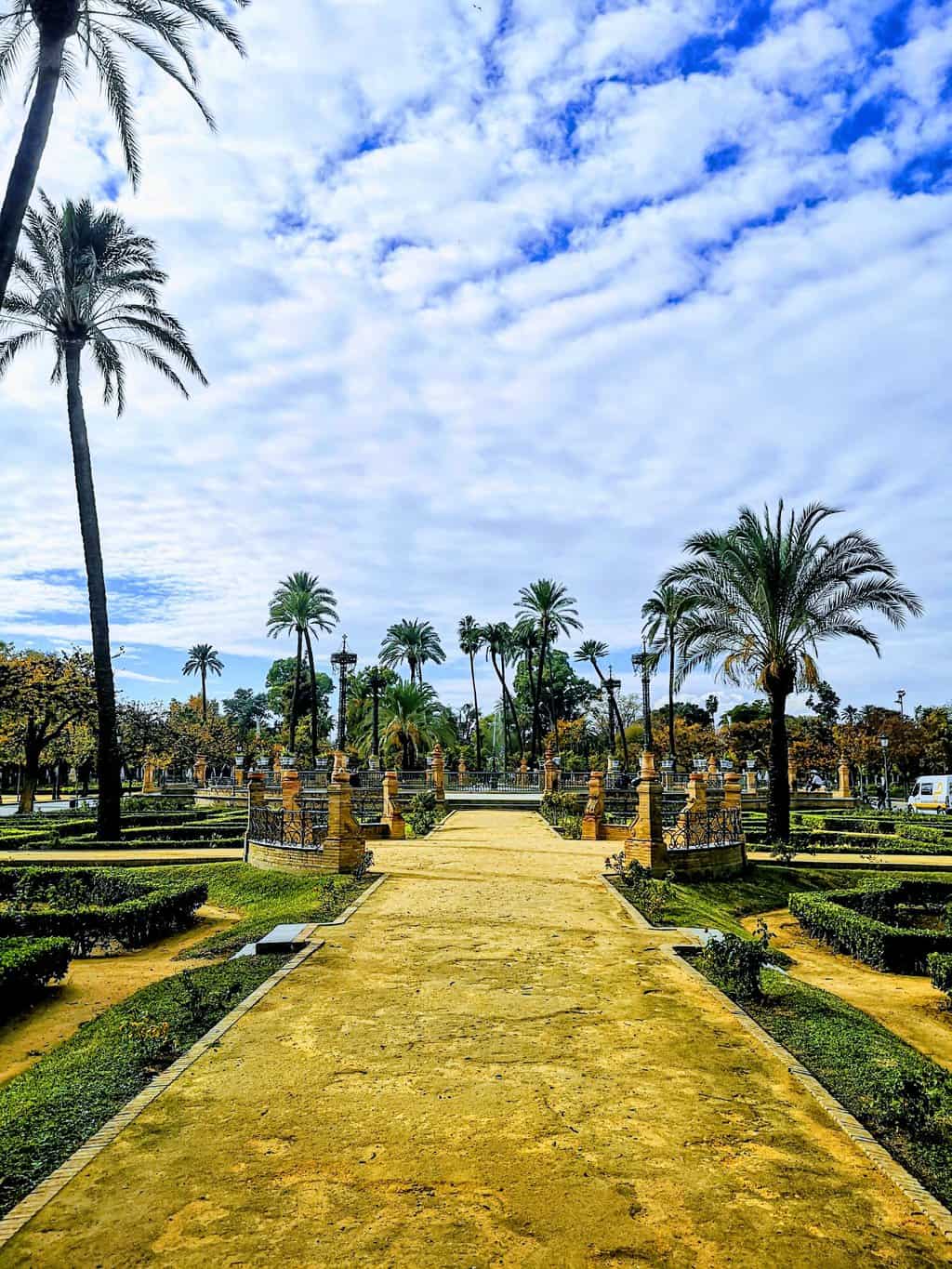
Jardines del Prado de San Sebastián
Tucked behind the Plaza Espana, and often overshadowed by the Parque de Maria Luisa, are the San Sebastian gardens. This is another great place to find some peace and quiet in the city. There are a couple of cafes with outside seating here, and in the winter months, you can often find a pop up ice skating rink.
Paseo del Rio Guadalquivir
The Rio Guadalquivir is a pedestrian walking path that runs alongside the canal skirting the edge of the El Centro neighbourhood. You can follow it from the Parque de María Luisa all the way to the Del Cachorro bridge. Along the way, you’ll pass various cafes, kiosks and landmarks, including the Torre del Oro – a defensive watchtower, dating back to 1220.
Centro Comercial Torre Sevilla
If you want to do some shopping, then you can head to the Centro Commercial. Located on the opposite side of the canal, you can cross the Del Cachorro bridge. There are also various well known fast food outlets here
Go shopping on Calle Sierpes
This is a busy shopping street which runs right through the centre of the El Centro neighbourhood, eventually joining up with Avenue de la Constitución. You will find mainstream brands alongside local, independent shops. With lots of cafes, restaurants and food outlets.
Wander the Jewish Quarter
The Jewish Quarter is actually a neighbourhood rather than a single sight or attraction, but it is worth mentioning as it is a really charming area to wander around. The Jewish Quarter is a pretty area of the city, with a maze of narrow streets and historic and interesting churches, landmarks and buildings with little cafes tucked away inside.
Setas de Sevilla
This giant wooden sculpture is hard to miss! Hang out underneath the structure or purchase a ticket to access the raised walkway and viewing platform. Tickets are also available to visit at night, when the sculpture is illuminated with bright colours.
During the day, you can also visit the Encarnación food market, which sits underneath the sculpture to pick up some tasty local produce.
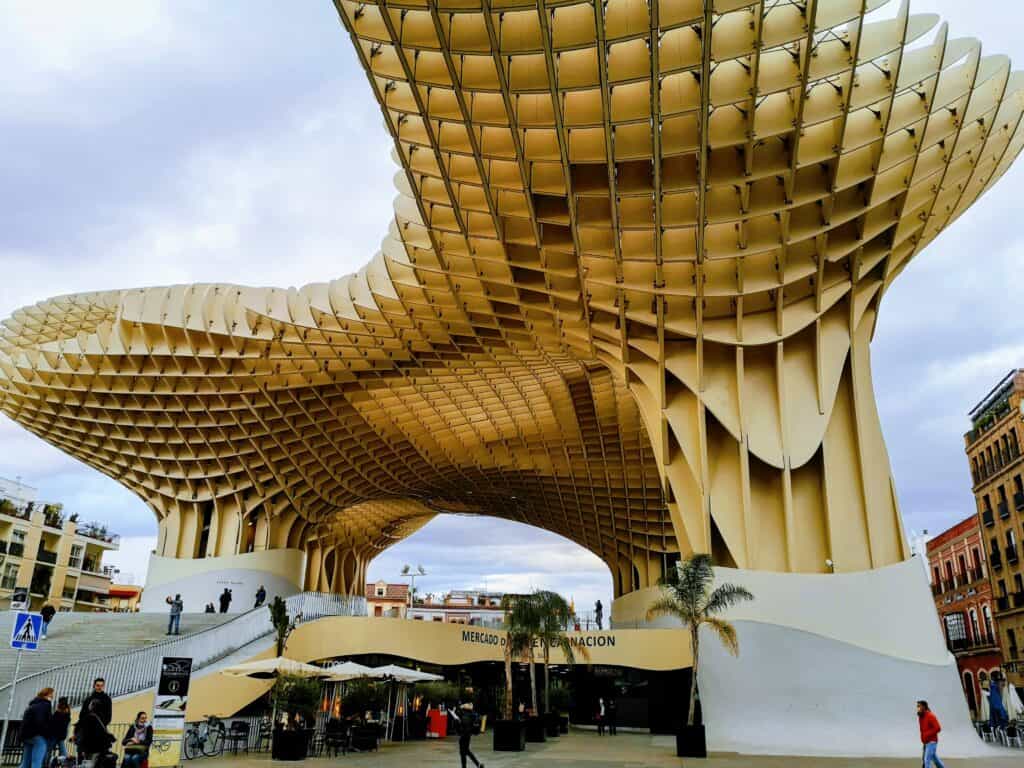
Day trips from Seville
I’ve visited Andalusia several times in the last few years and I absolutely love it. It is such a beautiful region of Spain. If you have longer than 3 days to spend in Seville, I would highly recommend taking a day trip to explore the wider area of Andalusia.
There are many organised tours you can take from Seville. Or, if you prefer to have more flexibility, then another great option is to rent a car for the day.
Cordoba
Cordoba is one of the most popular day trips from Seville, due to its proximity and ease of travel.
What is there to do in Cordoba?
The main attraction in Cordoba is the La Mezquita mosque-cathedral. The impressive building and complex is a must-see when in Cordoba and tickets should be booked in advance to avoid disappointment.
Other sights in Cordoba include the Alcazar of Cordoba, Roman Bridge, Plaza des Tendillas and the Jewish quarter.
Travel from Seville to Cordoba
The quickest and best way to get to Cordoba from Seville is by train. The direct train takes just 45 minutes and costs approximately €20 each way. There are also many organised tours that will leave to Cordoba from Seville if you prefer.
Cadiz
Cadiz is known for being the oldest city in western Europe. Situated on the Andalusian-Atlantic coast, it is home to the Spanish Navy and was an important Port city, with over 100 watchtowers.
What is there to do in Cadiz?
The historic city of Cadiz is a perfect day trip destination from Seville. The largely pedestrianised Old Town of Cadiz is great for exploring on foot, with plenty of cafes and tapas bars to rest and enjoy some local cuisine. Visit the Cathedral, and the castle of Santa Catalina and San Sebastian. Stroll along La Caleta beach and through the Genoves park.
Travel from Seville to Cordoba
Cadiz is only 80 minutes by car from Seville, so renting a car for the day is the most convenient option. However, if you prefer, you can also take a bus from Seville to Cadiz. The journey will take you around 1 hour 45 minutes.
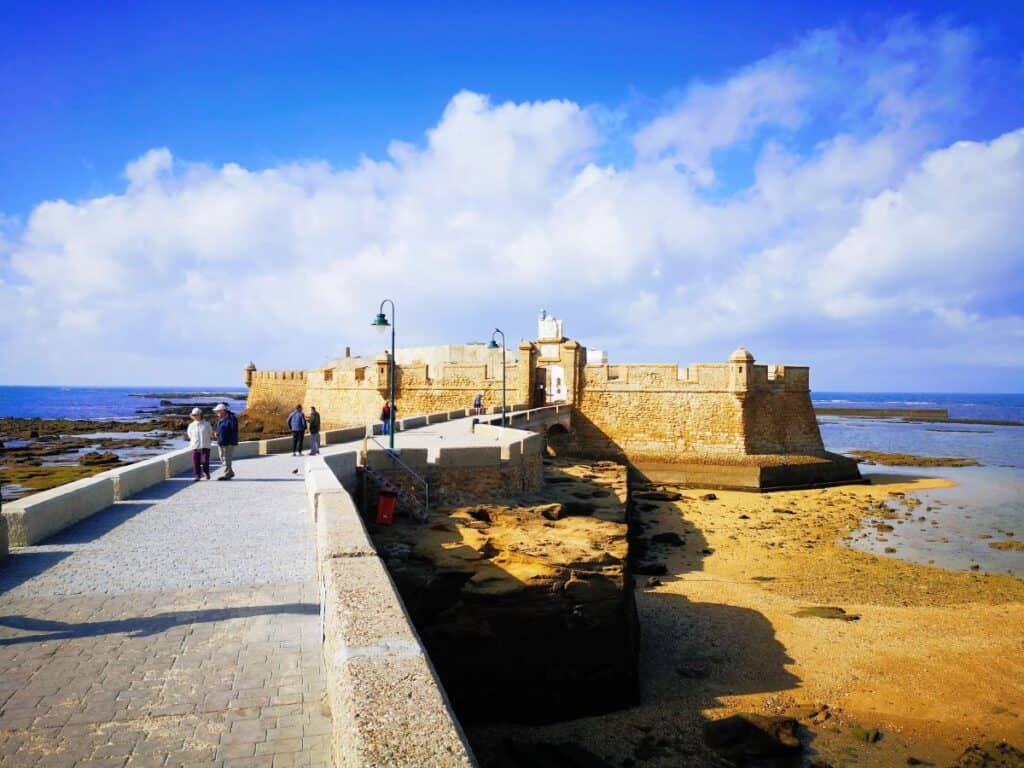
Malaga
Malaga is a fantastic city to visit and is one of the most popular city break destinations in Southern Spain, alongside Seville. If you have more time, I would recommend spending 3 days in Malaga. If you arrived in Seville via Malaga airport, make sure you have at least one night in Malaga either before or after your trip to Seville.
What is there to do in Malaga?
Malaga is a vibrant city with beautiful historic buildings and a charming old town. Visit the Alcazaba of Malaga, and see the Roman Amphitheatre. Stroll around the ruins of Gibralfaro castle with sweeping 360 views over Malaga’s mountain range, city and sea.
Have a leisurely lunch in one of the many restaurants in Malaga’s Port, walk along the seafront promenade and relax on Malagueta beach. Go shopping in the old town, visit the impressive Malaga Cathedral and enjoy a drink in one of the many tapas bars.
Travel from Seville to Malaga
There are two main ways to travel to Malaga from Seville. Either by train or by car. The train takes approximately 2 hours and costs around €46 each way. Driving will take 2 hours 20 if you take the toll road, or 2 hours 45 mins if you choose not to take the route with tolls.
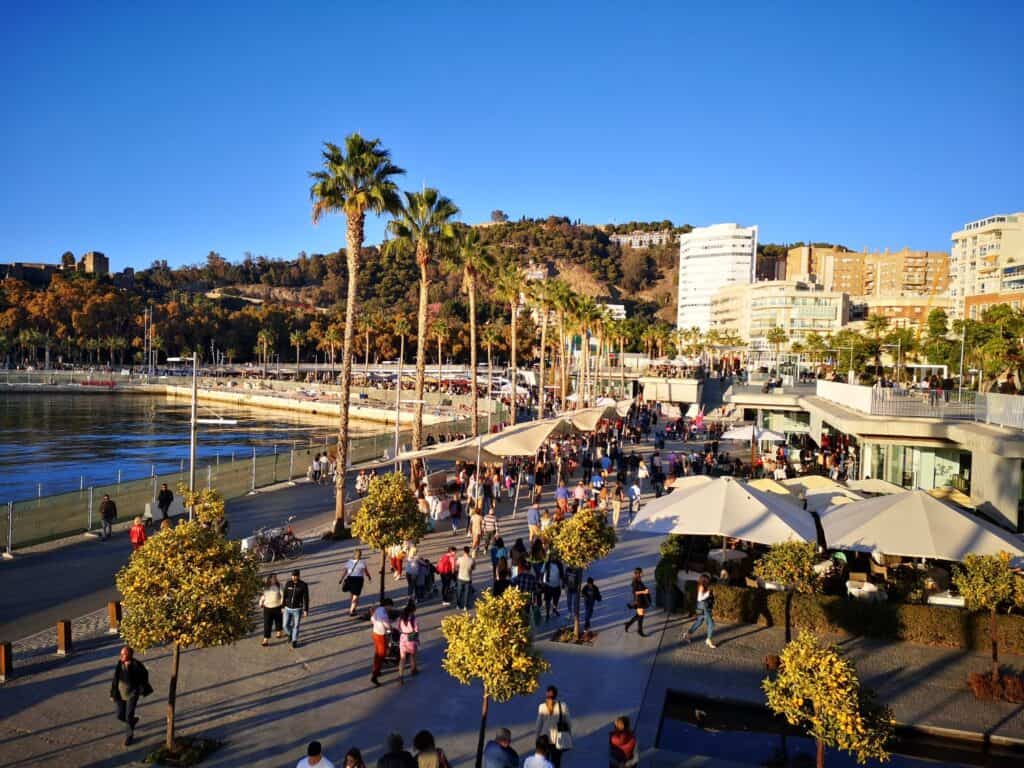
Other day trips from Seville
There are so many great places to visit in Andalucia, it is hard to include them all! Other worthy places to visit, which are a little bit further away from Seville include Granada, where you can wander around the famous Alhambra Palace.
Ronda is another great option, where the impressive Puente Nuevo bridge straddles a 120m deep gorge which has split the historic town in half.
Or, if you are looking for something a little more adventurous, join a trip to hike the famous Caminito del Rey – once known as Europe’s most dangerous hike!

